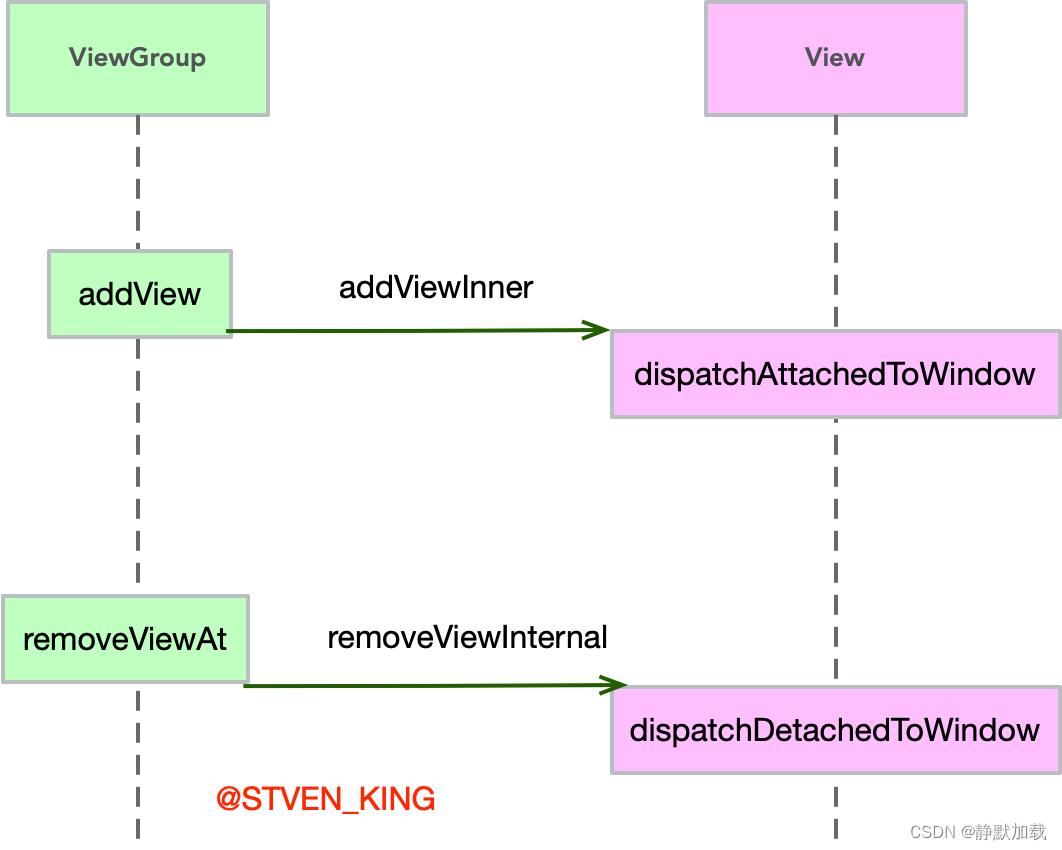由View的onAttachedToWindow引发的图片轮播问题探究
Posted 静默加载
tags:
篇首语:本文由小常识网(cha138.com)小编为大家整理,主要介绍了由View的onAttachedToWindow引发的图片轮播问题探究相关的知识,希望对你有一定的参考价值。
由View的onAttachedToWindow引发的图片轮播问题探究

文章目录
前言
本篇文章是在View的postDelayed方法深度思考这篇文章的所有的基础理论上进行研究的,可以说是对于View的postDelayed方法深度思考这篇文章知识点的实践。
某天同事某进在做一个列表页添加轮播Banner的需求的时候,发下偶尔会出现轮播间隔时间错乱的问题。
我看了他的轮播的实现方案:利用Handle.postDelayed间隔轮播时长每次执行完轮播之后再次循环发送;

代码貌似没有太大问题,但通过现象看来应该是removeCallbacks失效了~!
Handle#removeCallbacks
在stackoverflow上找了相关资料Why to use removeCallbacks() with postDelayed()?,之后尝试将postDelayed不靠谱那么改为post,发现貌似轮播间隔时间错乱的问题解决了~!
虽然不清楚什么原因导致问题不再出现,但后续因为其他工作打断未能继续排查下去。
若干天之后,再次发现轮播间隔时间错乱的问题有一次出现了。
这次我们使用自定
Handler进行removeCallBacks和postDelayed,完美的解决了问题。
下面记录一下整问题解决过程中的思考~!
待解决问题
View.removeCallbacks是否真的可靠;View.post和View.postDelayed相比为什么bug复现频率更低;
View#dispatchAttachedToWindow
Handle的removeCallBacks移除方法是不可靠的么?如果当前的任务不是在执行中,那么该任务一定会被移除。
换句话说,Handle#removeCallBacks移除的就是在队列中等待被执行的Message。
那么问题到底出在哪里,而且为什么
postDelayed替换为post问题的复现概率降低了?
这次有些时间,跟了一下源码发现使用View#postDelayed发送的消息不一定会立即被放在消息队列。
回顾之前View的postDelayed方法深度思考这篇文章中关于View.postDelayed小结中的描述:
postDelayed方法调用的时候,如果当前的View没有依附在Window上的时候,先将Runnable缓存在RunQueue队列中。等到View.dispatchAttachedToWindow调用之后,再被ViewRootHandler进行一次postDelayed。这个过程中相同的Runnable只会被postDelay一次。
我们打印stopTimer和startTimer方法执行的时ViewPager#getHandler的Handler实例,发现在列表快速滑动时大部分为null。
好吧,之前忽略了这个Banner在滑动过程中的被View#dispatchDetachedFromWindow。这个方法的调用会导致View内部的Handle为null。
如果View的Handle为null,那么Message的执行可能会收到影响。
在View的postDelayed方法深度思考这篇文章中关于mAttachInfo对于View.postDelayed的影响,也都进行了分析。这里我们捡主要的源码阅读一下。
//View.java
void dispatchAttachedToWindow(AttachInfo info, int visibility)
mAttachInfo = info;
/****部分代码省略*****/
// Transfer all pending runnables.
if (mRunQueue != null)
mRunQueue.executeActions(info.mHandler);
mRunQueue = null;
performCollectViewAttributes(mAttachInfo, visibility);
onAttachedToWindow();
/****部分代码省略*****/
public boolean postDelayed(Runnable action, long delayMillis)
final AttachInfo attachInfo = mAttachInfo;
if (attachInfo != null)
return attachInfo.mHandler.postDelayed(action, delayMillis);
// Postpone the runnable until we know on which thread it needs to run.
// Assume that the runnable will be successfully placed after attach.
getRunQueue().postDelayed(action, delayMillis);
return true;
public boolean post(Runnable action)
final AttachInfo attachInfo = mAttachInfo;
if (attachInfo != null)
return attachInfo.mHandler.post(action);
// Postpone the runnable until we know on which thread it needs to run.
// Assume that the runnable will be successfully placed after attach.
getRunQueue().post(action);
return true;
public boolean removeCallbacks(Runnable action)
if (action != null)
final AttachInfo attachInfo = mAttachInfo;
if (attachInfo != null)
attachInfo.mHandler.removeCallbacks(action);
attachInfo.mViewRootImpl.mChoreographer.removeCallbacks(
Choreographer.CALLBACK_ANIMATION, action, null);
getRunQueue().removeCallbacks(action);
return true;
post和postDelayed在View的postDelayed方法深度思考这篇文章中进行过讲解,会在View执行dispatchAttachedToWindow方法的时候执行RunQueue中存放的Message。
RunQueue.executeActions是在ViewRootImpl.performTraversal当中进行调用;
RunQueue.executeActions是在执行完host.dispatchAttachedToWindow(mAttachInfo, 0);之后调用;
RunQueue.executeActions是每次执行ViewRootImpl.performTraversal都会进行调用;
RunQueue.executeActions的参数是mAttachInfo中的Handler也就是ViewRootHandler;
从这里看也是没有任何问题的,我们使用View#post的消息都会在View被Attached的时候进行执行;
一般程序在开发的过程中,如果涉及容器的使用那么必然需要考虑的生产和消费两个情况。
上面的源码我们是看了到了消息被执行的逻辑(最终所有的消息都会被放在MainLooper中被消费),如果涉及消息被移除呢?
public class HandlerActionQueue
public void removeCallbacks(Runnable action)
synchronized (this)
final int count = mCount;
int j = 0;
final HandlerAction[] actions = mActions;
for (int i = 0; i < count; i++)
if (actions[i].matches(action))
// Remove this action by overwriting it within
// this loop or nulling it out later.
continue;
if (j != i)
// At least one previous entry was removed, so
// this one needs to move to the "new" list.
actions[j] = actions[i];
j++;
// The "new" list only has j entries.
mCount = j;
// Null out any remaining entries.
for (; j < count; j++)
actions[j] = null;
移除消息的时候如果当前View的mAttahInfo为空,那么我们只会移除RunQuque中换缓存的消息。。。
哦哦
原来是这样啊~!
确实只能这样~!
总结一下,如果View#mAttachInfo不为空那么你好,我好,大家好。否则View#post的消息会在缓存队列中等待被添加,但移除的消息却只能移除RunQueue中缓存的消息。如果此时RunQueue中的消息已经被同步到MainLooper中那么,抱歉没有View#mAttachInfo臣妾移除不了呀。
按照之前的业务代码,如果当前
View被dispatchDetachedFromWindow之后执行消息的移除操作,那么已经在MainLooper队列中的消息是无法被移除且如果继续添加轮播消息,那么就会造成轮播代码块的频繁执行。
文字描述可能一时间不太容易理解,下面是一次超预期之外的轮播(为什么会有多个轮播消息)流程简单的分析图:

再说post和postDelayed
如果只看相关源码我感觉是发现不了问题了,因为post最后执行的也是postDelayed方法。所以两者相比只不过时间差而已,这个时间差能造成什么影响呢?
回头看了看自己之前写的文章又一年对Android消息机制(Handler&Looper)的思考,其中有一个名词叫做同步屏障。
同步屏障:忽略所有的同步消息,返回异步消息。再换句话说,同步屏障为
Handler消息机制增加了一种简单的优先级机制,异步消息的优先级要高于同步消息。
而同步屏障用的最多的就是页面的刷新(ViewRootImpl#mTraversalRunnable)相关文章可以阅读Android系统的编舞者Choreographer,而ViewRootImpl的独白,我不是一个View(布局篇)这篇文章讲述了View#dispatchAttachedToWindow的方法就是由ViewRootImpl#performTraversals触发的。
为什么要说同步屏障呢?上面的超预期轮播的流程图中可以看出View#dispatchAttachedToWindow的方法调用对于整个流程非常重要。移除和添加两个消息两个如果由于postDelayed导致中间有其他消息的插入,而同步屏障是最有可能被插入的消息且这条消息会使View#mAttachInfo产生变化。
这就使原来有些小问题的代码雪上加霜,bug更容易复现。
话说RecycleView
为什么要提到这个问题,因为好多时候我们使用View.post执行任务是没有问题(PS:我感觉这个观点也是这个问题产生的最初的源头)。
我们知道RecycleView的内部子View仅仅是比屏幕大小多出一条预加载View,超过这个范围或者进入这个范围都会导致View被添加和移除。
public class RecyclerView extends ViewGroup implements ScrollingView, NestedScrollingChild2
/***部分代码省略***/
private void initChildrenHelper()
this.mChildHelper = new ChildHelper(new Callback()
public int getChildCount()
return RecyclerView.this.getChildCount();
public void addView(View child, int index)
RecyclerView.this.addView(child, index);
RecyclerView.this.dispatchChildAttached(child);
public int indexOfChild(View view)
return RecyclerView.this.indexOfChild(view);
public void removeViewAt(int index)
View child = RecyclerView.this.getChildAt(index);
if (child != null)
RecyclerView.this.dispatchChildDetached(child);
child.clearAnimation();
RecyclerView.this.removeViewAt(index);
/***部分代码省略***/
/***部分代码省略***/

如果我们频繁来回滑动列表,那么这个Banner会不断的被执行dispatchAttachedToWindow和dispatchDetachedToWindow。
这样导致View#mAttachInfo大部分时间为null,从而影响到业务代码中往主线程中发送的Message的执行逻辑。
文章到这里就讲述的差不多了,解决这个问题给我带来的感受挺深刻的,之前学习android系统的相关源码只不过是大家都在学、面试都在问。
能在应用到实际研发过程中涉及到的知识点还是比较少,好多情况下都是能解决问题就行,也就是知其然而不知其所以然。
这次解决的问题能让我深切感受到fuck the source code is beatifully。
文章到这里就全部讲述完啦,若有其他需要交流的可以留言哦~!
2023年祝你在新一年心情日新月异,快乐如糖似蜜,朋友重情重义,爱人不离不弃,工作频传佳绩,万事称心如意!
以上是关于由View的onAttachedToWindow引发的图片轮播问题探究的主要内容,如果未能解决你的问题,请参考以下文章